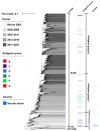Status and Challenges for Vaccination against Avian H9N2 Influenza Virus in China
- PMID: 36143363
- PMCID: PMC9505450
- DOI: 10.3390/life12091326
Status and Challenges for Vaccination against Avian H9N2 Influenza Virus in China
Abstract
In China, H9N2 avian influenza virus (AIV) has become widely prevalent in poultry, causing huge economic losses after secondary infection with other pathogens. Importantly, H9N2 AIV continuously infects humans, and its six internal genes frequently reassort with other influenza viruses to generate novel influenza viruses that infect humans, threatening public health. Inactivated whole-virus vaccines have been used to control H9N2 AIV in China for more than 20 years, and they can alleviate clinical symptoms after immunization, greatly reducing economic losses. However, H9N2 AIVs can still be isolated from immunized chickens and have recently become the main epidemic subtype. A more effective vaccine prevention strategy might be able to address the current situation. Herein, we analyze the current status and vaccination strategy against H9N2 AIV and summarize the progress in vaccine development to provide insight for better H9N2 prevention and control.
Keywords: H9N2 AIV; antigenicity; influenza virus; vaccine.
Conflict of interest statement
The authors declare no conflict of interest.
Figures

Similar articles
-
Efficacy of an inactivated bivalent vaccine against the prevalent strains of Newcastle disease and H9N2 avian influenza.Virol J. 2017 Mar 16;14(1):56. doi: 10.1186/s12985-017-0723-7. Virol J. 2017. PMID: 28302119 Free PMC article.
-
Molecular and Antigenic Characterization of Avian H9N2 Viruses in Southern China.Microbiol Spectr. 2022 Feb 23;10(1):e0082221. doi: 10.1128/spectrum.00822-21. Epub 2022 Jan 12. Microbiol Spectr. 2022. PMID: 35019707 Free PMC article.
-
Development of an Inactivated Avian Influenza Virus Vaccine against Circulating H9N2 in Chickens and Ducks.Vaccines (Basel). 2023 Mar 5;11(3):596. doi: 10.3390/vaccines11030596. Vaccines (Basel). 2023. PMID: 36992180 Free PMC article.
-
Sporadic occurrence of H9N2 avian influenza infections in human in Anhui province, eastern China: A notable problem.Microb Pathog. 2020 Mar;140:103940. doi: 10.1016/j.micpath.2019.103940. Epub 2019 Dec 18. Microb Pathog. 2020. PMID: 31863839
-
A brief summary of the epidemiology and genetic relatedness of avian influenza H9N2 virus in birds and mammals in the Middle East and North Africa.Epidemiol Infect. 2017 Dec;145(16):3320-3333. doi: 10.1017/S0950268817002576. Epub 2017 Nov 23. Epidemiol Infect. 2017. PMID: 29168447 Free PMC article. Review.
Cited by
-
The emergence of new antigen branches of H9N2 avian influenza virus in China due to antigenic drift on hemagglutinin through antibody escape at immunodominant sites.Emerg Microbes Infect. 2023 Dec;12(2):2246582. doi: 10.1080/22221751.2023.2246582. Emerg Microbes Infect. 2023. PMID: 37550992 Free PMC article.
-
Expression and delivery of HA1-M2e antigen using an innovative attenuated Salmonella-mediated delivery system confers promising protection against H9N2 avian influenza challenge.Poult Sci. 2025 Jan;104(1):104602. doi: 10.1016/j.psj.2024.104602. Epub 2024 Nov 27. Poult Sci. 2025. PMID: 39631285 Free PMC article.
-
Molecular patterns of matrix protein 1 (M1): A strong predictor of adaptive evolution in H9N2 avian influenza viruses.Proc Natl Acad Sci U S A. 2025 Mar 4;122(9):e2423983122. doi: 10.1073/pnas.2423983122. Epub 2025 Feb 28. Proc Natl Acad Sci U S A. 2025. PMID: 40020189
-
The PB1 protein of H9N2 influenza A virus inhibits antiviral innate immunity by targeting MAVS for TRIM25-mediated autophagic degradation.Poult Sci. 2025 Jan;104(1):104639. doi: 10.1016/j.psj.2024.104639. Epub 2024 Dec 4. Poult Sci. 2025. PMID: 39647358 Free PMC article.
-
Proposal for a Global Classification and Nomenclature System for A/H9 Influenza Viruses.Emerg Infect Dis. 2024 Aug;30(8):1-13. doi: 10.3201/eid3008.231176. Emerg Infect Dis. 2024. PMID: 39043566 Free PMC article.
References
-
- Chen B.L., Zhang Z.J., Chen W.B. Study on avian influenza I. Isolation and preliminary serological identification of avian influenza A virus in chickens. China J. Vet. Med. 1994;10:3–5.
Publication types
Grants and funding
LinkOut - more resources
Full Text Sources

